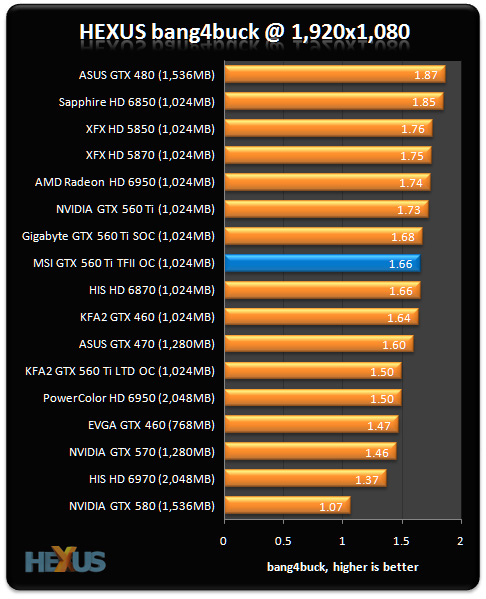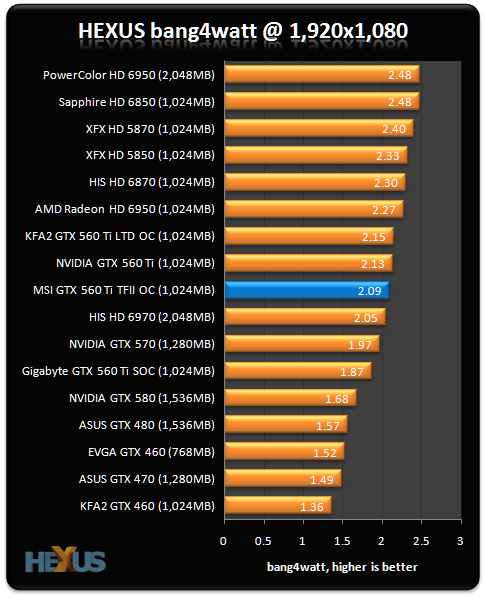HEXUS bang4buck and HEXUS bang4watt
Putting all the numbers into perspective, let's take a closer look at overall performance.
In a rough-and-ready assessment of the cards' bang for buck, we've aggregated the 1,920x1,080 frame-rates for seven games, normalised them* and taken account of the single-cards' prices.
But there are more provisos than we'd care to shake a stick at. We could have chosen seven different games, the cards' prices could have been derived from other sources and pricing tends to fluctuate daily, especially for new-release GPUs.
Consequently, the table below highlight a metric that should only be used as a yardstick for evaluating comparative performance with price factored in. Other architectural benefits are not covered, obviously.
| Aggregate FPS (1,920x1,080) |
Normalised* FPS (1,920x1,080) |
Current pricing | bang4buck (1,920x1,080) |
Power consumption** | bang4watt*** (1,920x1,080) |
|
|---|---|---|---|---|---|---|
| NVIDIA GeForce GTX 580 1,536MB | 494.20 | 422.60 | £395 | 1.07 | 252 | 1.68 |
| NVIDIA GeForce GTX 570 1,280MB | 436.90 | 385.95 | £265 | 1.46 | 196 | 1.97 |
| Gigabyte GeForce GTX 560 Ti SOC 1,024MB | 439.90 | 387.05 | £230 | 1.68 | 207 | 1.87 |
| KFA2 GeForce GTX 560 Ti LTD OC 1,024MB | 422.20 | 373.80 | £250 | 1.50 | 174 | 2.15 |
| MSI GeForce GTX 560 Ti Twin Frozr II OC 1,024MB | 405.30 | 357.75 | £215 | 1.66 | 171 | 2.09 |
| NVIDIA GeForce GTX 560 Ti 1,024MB | 374.10 | 328.65 | £190 | 1.73 | 154 | 2.13 |
| ASUS GeForce GTX 480 1,536MB | 432.60 | 384.20 | £205 | 1.87 | 244 | 1.57 |
| ASUS GeForce GTX 470 1,280MB | 348.90 | 304.45 | £190 | 1.60 | 204 | 1.49 |
| KFA2 GeForce GTX 460 1,024MB | 286.70 | 229.75 | £140 | 1.64 | 169 | 1.36 |
| EVGA GeForce GTX 460 768MB | 262.40 | 198.00 | £135 | 1.47 | 130 | 1.52 |
| HIS Radeon HD 6970 2,048MB | 413.10 | 375.75 | £275 | 1.37 | 183 | 2.05 |
| PowerColor Radeon HD 6950 2,048MB | 371.70 | 337.55 | £225 | 1.50 | 155 | 2.18 |
| AMD Radeon HD 6950 1,024MB | 374.50 | 339.75 | £195 | 1.74 | 150 | 2.27 |
| HIS Radeon HD 6870 1,024MB | 328.40 | 289.70 | £175 | 1.66 | 126 | 2.30 |
| Sapphire Radeon HD 6850 1,024MB | 288.40 | 240.60 | £130 | 1.85 | 97 | 2.48 |
| XFX Radeon HD 5870 1,024MB | 365.00 | 333.30 | £190 | 1.75 | 139 | 2.40 |
| XFX Radeon HD 5850 1,024MB | 312.60 | 272.40 | £155 | 1.76 | 117 | 2.33 |
* the normalisation refers to taking playable frame rate into account. Should a card benchmark at over 60 frames per second in any one game, the extra fps count as half. Similarly, should a card benchmark lower, say at 40fps, we deduct half the difference from its average frame rate and the desired 60fps, giving it a HEXUS.bang4buck score of 30 marks. The minimum allowable frame rate is 20fps but that scores zero.
** the GPU power consumption is derived from subtracting a flat rate of 100W - indicating system power-draw without a card - from the Call of Duty: Black Ops load figure. While this figure isn't solely indicative of power pulled by the GPU, as the CPU also throttles up, it's a better metric than using peak system-draw alone.
*** the HEXUS.bang4watt score is a crude measurement of how much normalised performance the GPU provides when evaluated against GPU power-draw that's shown in the table: the former is divided by the latter. We're using the peak power-draw numbers obtained by running real-world Call of Duty: Black Ops.
Analysis
MSI's GTX 560 Ti Twin Frozr II lands close to the middle on our bang4buck chart, but Gigabyte's competitively-priced 1,000MHz Super Overclock card has the edge.
The bad news for GTX 560? AMD's Radeon HD 6950 1GB - now available at around the £195 mark - offers very similar performance for less. And, if you're shopping for a bargain, Sapphire's Radeon HD 6850 is going for a penny less than £130 at the time of writing - that price is enough for it shoot up close to the top of the chart.
NVIDIA's GeForce 500-series cards have done well to reduce power consumption when compared to the first run of Fermi-derived products, but the performance-per-watt metric continues to be dominated by AMD.











